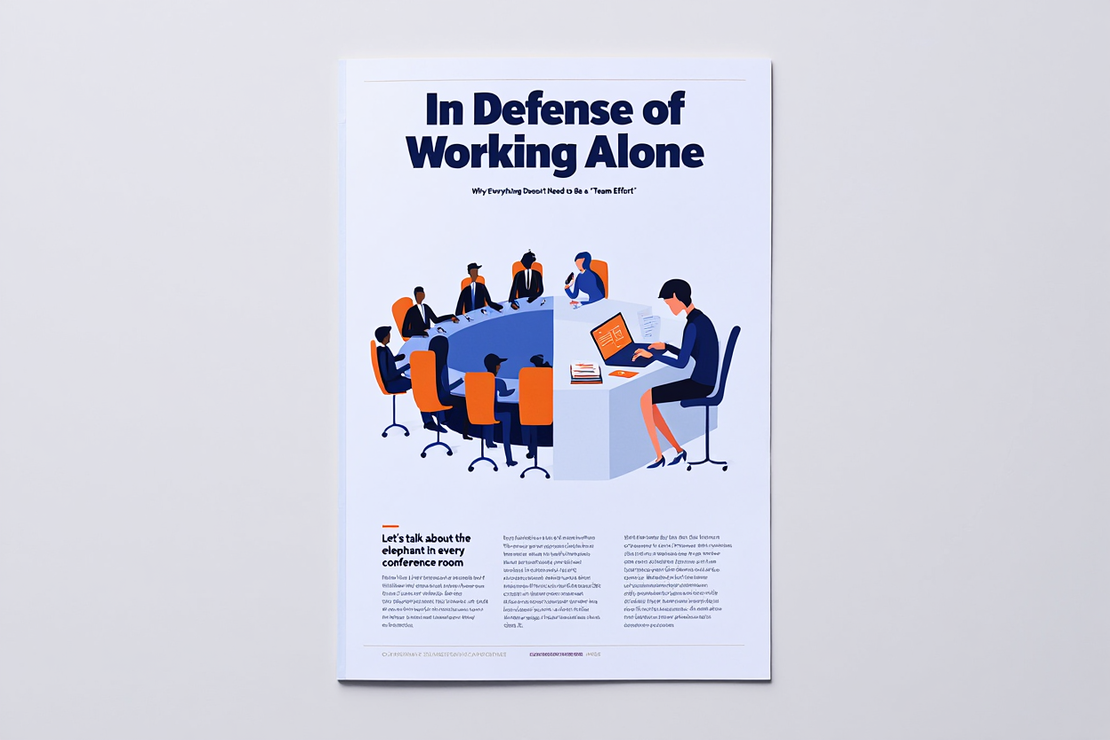
In defense of working alone
- pk
- Software , Productivity , Life
- August 2, 2025
Table of Contents
Why Everything Doesn’t Need to Be a “Team Effort”
Let’s talk about the elephant in every conference room: corporate teamwork is largely a joke.
You know it. We know it. But somehow, we’re all still pretending that “collaboration” is the secret sauce to success. It’s not. It’s the ketchup we slather on mediocrity to make it palatable.
Sure, teamwork has its place. Diverse expertise can help spotting issues; a dusting of specialized expertise early on – think lawyers and engineers – can pare away dead ends. Teamwork can also reduce political opposition, both by spreading the news and co-opting team members because they were part of the process. Teamwork is a tool to be used when useful; It should not be the default decison process
The Reality Check
Remember group projects in school? One or two people did all the work, while everyone else coasted and shared the credit. Congratulations - you’ve just discovered how most “teams” operate in the professional world!
Here’s what actually happens in professional services: a partner grabs an associate, maybe a paralegal, and gets the work done. That’s it. That’s the “team.” It’s not the UN General Assembly. You don’t need a Silicon Valley standup meeting to keep aligned. It’s a handful of competent people doing focused work.
Look at law firms - supposedly the pinnacle of professional teamwork. Harvard’s own research shows that lawyers are “notoriously bad at helping J.D.’s develop skills to work in teams."[1] Why? Because law schools evaluate students on individual performance. Because partners hoard clients like dragons hoard gold. Because, as one Harvard study delightfully put it, firms value “rock stars, not the whole band."[2]
The same goes for software development. Sure, we’ve got “scrum teams” and “agile methodologies,” but scratch the surface and what do you find? Usually it’s one or two people doing the real work on any subproject that matters. The Linux kernel? Linus Torvalds still personally reviews major changes. The BDFL (“Benevolent Dictator for Life”) model is extremely effective - and echos the Unix philosophy (aka The Unix Way): small, modular tools that do one thing well, often maintained by a single person or tiny group - which “compose” nicely together to build a reliable system. [3]
As one developer candidly admitted on Quora: “I far prefer to work alone and usually in the middle of the night. Unless we are talking millions of lines of code, a team is not necessary."[4]
The Auteur Advantage
This isn’t just bound to the technical work - we can shift focus to so-called creative work. Think about film directors. Christopher Nolan doesn’t crowdsource his vision to a committee. Neither did Stanley Kubrick or Alfred Hitchcock. The value of a crew can’t be understated, but the vision - the thing that makes their work distinctive - came from one mind that could hold the entire complex system in their head.
That’s the thing about individuals: one person can understand the broader set of connections, the subtle interplays, the gestalt of a project in a way that committees or aggregates of specialists never can. When you distribute decision-making, you lose coherence. You get a camel when you are trying to design a racehorse.
The Amazon Exception & the MBA Industrial Complex
Jeff Bezos figured something out that most companies haven’t: meetings (the quintessential team overhead ritual) make you dumber. That’s why Amazon starts meetings with silent reading. Everyone reads a six-page memo - written by one person, not a committee - and thinks about it in silence.[6]
Why? Because when you discuss things out loud in groups, you don’t get the truth. You get the composite of everyone’s views, watered down to the lowest common denominator. You get groupthink dressed up as truth - and consensus doesn’t equal truth. Writing forces clarity. Silence forces thought. And individual ownership forces accountability.
Business schools have sold us a bill of goods. They’ve convinced generations of managers that success comes from “synergy” and “cross-functional collaboration.” The Kellogg School of Management even proudly states that “most projects and assignments are completed in teams."[7] They pump out graduates who believe that every problem needs a committee, every decision needs consensus, and every project needs a team lead, a scrum master, and seventeen stakeholders. It’s garbage.
The dirty secret? Many MBAs end up in consulting or banking, where the real model is this: one or two smart people do the actual work, then a team of juniors makes it look pretty in PowerPoint. That’s not collaboration - it’s theater.
Why We Pretend Otherwise
So why do we keep up this charade? Three reasons:
It sounds good in pitches. Clients love hearing about your “integrated team approach” and your “collaborative culture.” It makes them feel like they’re getting the full force of your organization, not just Bob (from marketing).
It justifies overhead. If you admit that most work gets done by individuals or tiny groups, how do you justify all those middle managers? All those team-building retreats? All those collaboration tools that nobody actually uses?
You don’t sound like an asshole. Nobody wants to say: “Actually, I work better alone.” Socially, we don’t like being the tall blade of grass so we’re willing to ruin the bottom line to keep up this charade.
The Solo Professional Renaissance
Here’s the plot twist: technology is making the solo professional more powerful than ever. You don’t need a team when you’ve got an AI suite that can research faster than ten associates. You don’t need a marketing department when you can reach thousands directly through social media with a meaningful message that the readers will actually appreciate. You don’t need layers of management when you can deliver value directly to clients.
The most successful professionals we know? They work with tiny, trusted teams. They outsource the busy work. They focus on what they do best. They don’t waste time in meetings about meetings.
Look, we’re not saying teamwork is always useless. Sometimes you need diverse expertise. We frequently benefit from a partner to edit and catch your blind spots. The best work genuinely benefits from gathering and incorporating different perspectives. The most talented people “make their strengths effective and their weaknesses irrelevant” [8] by leveraging others, including spotting places where a specialist (probably working alone) should be brought in to really move the needle.
But let’s stop pretending that everything needs to be a team effort. Let’s stop turning every task into a committee project. Let’s stop valuing process over product.
Real work - the kind that moves needles and changes games - often happens when talented people are left alone to think, create, and execute. It happens when professionals are trusted to use their judgment rather than seeking consensus. It happens when we stop managing and start doing. Let them cook!
The Bottom Line
The next time someone suggests forming a task force, creating a working group, or “leveraging team synergies,” ask yourself: Could one competent person just handle this?
The answer is often yes.
And that’s not a bug. That’s a feature.
Because while everyone else is stuck in meetings, the solo professionals and small teams are out there getting things done. They’re the ones eating your lunch while you’re still debating what to order.
Want to build something meaningful? Start by acknowledging this truth: most great work isn’t done by committee. It’s done by individuals who give a damn, know their craft, and aren’t afraid to own the outcome.
Everything else is just expensive theater.
Sources
[1] https://clp.law.harvard.edu/article/collaboration-in-law-firms/
[2] https://www.legalevolution.org/2020/08/lawyers-and-teamwork-part-i-188/
[3] https://en.wikipedia.org/wiki/Unix_philosophy
[4] https://www.quora.com/As-a-software-developer-do-you-prefer-working-alone-or-in-teams
[6] https://www.inc.com/justin-bariso/jeff-bezos-knows-how-to-run-a-meeting-here-are-his-three-simple-rules.html
[7] https://menlocoaching.com/mba-applications-and-admissions-guide/mba-for-consulting/
[8] https://www.azquotes.com/author/4147-Peter_Drucker/tag/weakness



